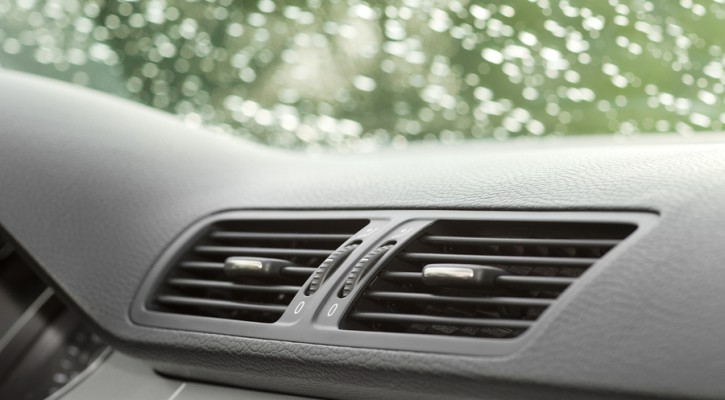
Tips To Cool Down a Hot Car Down Quickly
June 5, 2014
Driving an oven is dangerous. Follow these tips on how to cool down a hot car during the sweltering summer months:
1. Roll down all the windows. For better circulation, don’t roll them down together, but one after the other.
2. Crank up the air-conditioner. Be sure to put it on the fresh air setting, not the recirculate setting since the temperature outside will be much cooler.
3. Drive for a minute before rolling up the windows to allow all the hot air to escape.
4. Once the air from the A/C vents feels cooler than the air outside, it’s time to roll up the windows.
If your car is too hot to handle safely (the metal causes third-degree burns, the seats are melting, and the steering wheel is too hot to touch), then try this nifty trick from LifeHacker before hitting the road:
http://lifehacker.com/5823069/how-to-quickly-cool-down-your-cars-oven-like-interior
This trick from fine folks at lifehacker may look a little funny, but it’s one of the fastest ways to cool down a hot car when summer heat really gets it baking.

Gas Mileage Dilemma: AC and MPG
June 3, 2014
There has been a shift in the age-old debate over air-conditioning and gas mileage.
Once upon a time, drivers would roll down their windows on a hot day. They assumed that it would waste less gas than running the air conditioner. Then, one hot summer day, some “experts” told the public that driving with the windows up and the air-conditioning on would result in better gas mileage than rolling the windows down. Their argument: rolling down the windows created more drag, and that resistance used more gas than the AC.
However, it appears that this argument was based more on theory than fact (or possibly they were just sick of being hot). Years of testing by actual drivers, as well as studies done by Edmunds.com, the Society of Automotive Engineers (SAE), and Consumer Reports revealed that gas mileage is actually better with the windows down and the AC off. And so, the debate over AC and MPG wages on.
Of course, this doesn’t mean that you have to suffer through the heat wave without any air-conditioning. It would definitely be less cost efficient to have a heat stroke and crash your car than to simply turn on the AC every once in a while. However, if you want to get the most out of your gas mileage then consider cruising with the windows down and dressing for the weather.
For more information on air-conditioning and gas mileage, see the full story below:
http://greenliving.about.com/od/travelinggreen/a/Air-Conditioning-MPG-Gas-Mileage.htm

Tire Safety 101
June 2, 2014
It’s National Tire Safety Week all week long, so today we’re going to break down the basics of tire safety for your cars and trucks.
Tires keep us moving, help us stop, maintain traction and play one of the most important roles in keeping control over our vehicles. Without reliable, properly-inflated tires, cars and trucks can quickly turn into rolling death machines. And, even a slight drop in tire pressure can really drag our gas mileage down. So, it’s important to get in the habit of practicing proper tire safety.
1. Check tire pressure AT LEAST once a month.
Tires typically drop about 1 psi per month, and 1 psi for each 8-degree loss in ambient temperature. In many places across the U.S., temperatures can range far greater than 8-degrees in a single day. So, if your region is experiencing drastic temperature changes, it couldn’t hurt to check tire pressure weekly or even daily.
Uneven tire pressure immediately affects handling and control, as well as gas mileage. However, the long term effects can be even more concerning. Tire life decreases with poorly inflated tires because the tread wears out quicker on the outer edges, as well as increases stress on the tire as a whole through flexing and overheating.
2. Inspect tires AT LEAST once a month.
This is easy. Just do a quick walk-around, looking for excessive tread wear, cracks, bumps, chunking, punctures, or debris (such as screws & rocks). If you notice excessive tread wear, it could be a sign of steering or suspension misalignment.
If you notice tire damage, it is easy & cheap to take it in for repairs.
3. Maintain tires in proper balance.
Ever hear a thumping noise when driving down the highway? It could be an out-of-balance tire. This can cause uneven tread damage as well as an uncomfortable and embarrassing ride. If this occurs, have your tires dynamically balanced by an experienced technician right away.
Tires should always be balanced when first installed, and whenever remounted.
4. Rotate tires every 6,000 miles.
This is a general rule of thumb, though different vehicle manuals may specify different miles.
5. Maintain steering and suspension in proper alignment.
Many tire service shops offer a free alignment with the purchase of new tires. This is important because misalignment can cause rapid tire wear, as well as affect steering and stability of the vehicle. If you notice that your car pulls to one direction or the other, it may be time for an alignment.
6. Never overload your vehicle.
Overloading is the second leading cause of tire failure, just behind underinflation. Check the tire sidewall for maximum load range.
7. Don’t overheat tires.
Heat is another big tire killer. High speeds, high loads, underinflation, course pavement and aggressive driving all increase tire temperatures. This drastically decreases tread life and damages tire structure.
8. Install tires in matched pairs or complete sets.
When replacing tires, buy the same size, brand and type. If you can’t afford a complete set, then try to at least get a pair and install together as rear wheels. Even if the vehicle is FWD or AWD, putting new tires on the front and worn tires on the back will cause instability.
9. Buy the right tires for your vehicle and location.
All-season tires may work well in various locations, however, specialized tires will perform better for driving in rain, snow, ice, off-road and long distance conditions.
10. Replace tires BEFORE they blowout.
If tire tread is running low, it’s time for the old penny test. The Lincoln’s head on a penny can be substituted for a tire tread depth gauge as tires wear to the critical final stages. Place a penny into several tread grooves across the tire. If part of Lincoln’s head is always covered by the tread, you have more than 2/32″ of tread depth remaining. If Lincoln’s head is not covered, then a blowout is imminent.
Now that you know a thing or two about tires, practice the wisdom, spread the wisdom, and be a knowledgeable tire-safety advocate.

Teen Drivers’ Summer Survival Guide
May 29, 2014
With the passing of Memorial Day weekend, teens now face the 100 deadliest days of driving this year. The school year comes to an end, summer begins and traffic fatalities sky rocket through June, July and August. Why?
One reason is simple: there are more teen drivers (aka novice drivers) on the road. In fact, one of the greatest dangers to teen drivers is other teen drivers. One way to avoid collisions with other teens is to take extra caution when driving through the usual hangouts, especially the mall.
Having multiple passengers can also increase a teen driver’s crash risk. The combination of multiple conversations, phone usage and loud music is common, and all this commotion in a confined space can easily lead to distracted driving accidents. As the driver, a smart teen should make it a priority to get everyone from point A to point B without crashing or getting pulled over. That will earn much more peer respect than driving distracted, carelessly or recklessly and putting everyone in danger.
Another common cause of summer traffic fatalities is alcohol. Not only must teen drivers steer clear of drinking while driving, they must also steer clear of other drivers under the influence. By avoiding alcohol-prone areas such as bar districts and party spots, teen drivers can manage to make it through the summer without an alcohol-related accident.
Since traffic fatalities are a leading cause of teen death, and fatality rates are 3X as high during the summer months, it is important for teen drivers to take these tips to heart.
Engine Rebuild: A Vivid Time-Lapse
May 28, 2014
Not many new drivers would attempt such a feat, but there is incredible value in learning the art of the engine rebuild. Done properly, and with the right guidance, this experience can make teens more aware of how their car works, how to take better care of it, and how to fix it without breaking the bank. It can also teach life-long lessons such as patience and ingenuity.
If you’re up to the challenge, consider investing in a vintage ride, a fixer-upper, or an old fashioned clunker to learn how engines work. But, be forewarned, it is NOT EASY.
Witness the beauty of one engine enthusiast’s time-lapse rebuild:

Motorcycle Awareness for the Clueless – Lesson 13
May 26, 2014
Lesson 13: Save Lives by Keeping the Roads Clean
Road debris is no big deal for people in cars and trucks, but it can result in a fatal crash when faced by unsuspecting bikers. Trash, gravel, and other common hazards can often be prevented by drivers who strive to keep the roads clean. So, take these tips to heart to save lives this riding season.
Keep gravel off the road by keeping your tires on the asphalt. Drifting into the shoulder can cause your tires to kick up gravel on the pavement, which can then cause traction issues for motorcyclists.
When hauling trash, yard trimmings or any household goods, be sure that everything is strapped down securely. Keep an eye on your load while driving to make sure that nothing comes loose during the move. A fallen cedar branch or lost bedside table could prove fatal for any bikers behind you.
Finally, drivers can keep the roads clean by following this age-old rule: DON’T BE A LITTERBUG! Keep your food, drinks, cigarette butts and other trash in the car until you reach a destination with a trash can.

Motorcycle Awareness for the Clueless – Lesson 12
May 23, 2014
Lesson 12: Play it safe, give bikers more space!
Welcome back for the 12th lesson in our Motorcycle Awareness Month series.
There are many reasons to give motorcyclists more space when following in traffic. For one, they can brake quicker. Motorcycles don’t have as much weight, so they tend to slow down at a much quicker pace than 4-wheeled vehicles. They also face more hazards, and are forced into situations that require quicker emergency braking more often. Road debris, distracted drivers, potholes and other traffic dangers are a constant threat when riding a motorcycle, so the possibility for fast deceleration is always there.
Motorcyclists also tend to notice and react to changes in traffic more quickly than drivers. Because they aren’t surrounded by four doors and a roof, they are more alert. Therefore, a biker may begin braking for a red light or stop sign long before other drivers even notice the intersection.
Since fender benders can result in a fatal injury when the collision involves a motorcycle, it is best to play it safe and allow plenty of following distance. So, don’t forget this most basic of motorcycle awareness lessons: Give motorcyclists more space!
Motorcycle Awareness for the Clueless – Lesson 11
May 22, 2014
Lesson 11: Roaring Engines Double as Warnings
For some drivers, it can be quite jarring to hear a motorcycle loudly rev up next to them in traffic. Sometimes bikers are simply showing off their engines, however, other times this loud noise can double as a warning when used in moving traffic.
Since many motorcycle horns aren’t nearly as loud as the engines they sit upon, motorcyclists sometimes rev up their engines to make enough noise for other drivers to know that they are there. This can be an effective technique when people in cars and trucks try to change lanes while the biker is in their blind spot.
So, if you hear an engine roar and a biker quickly ride past you, don’t be offended, and don’t take it as an invitation to drag race. This is simply a way of being noticed, and thereby avoiding getting run over by trucks and cars on the road.

Motorcycle Awareness for the Clueless – Lesson 10
May 21, 2014
Lesson 10: Why You Should Always Look Before Opening Your Door
Finding a place to park can be difficult at times, especially downtown where everyone wants to work & play. So when you finally find that coveted parking spot, carefully maneuvre into place with your parallel parking skills, and find your change for the meter, you may feel like it’s time to breathe a sigh of relief and rejoice in the conclusion of your downtown driving struggle. However, there is one last measure you must take before exiting the vehicle: CHECK FOR MOVING TRAFFIC BEFORE OPENING THE DOOR!
Opening your car door at the wrong time could cause serious damage if struck by another car or truck, and opening your car door when a motorcycle is passing by could cause serious injury or even death. So, prevent this unfortunate accident from happening by checking twice before exiting your vehicle.

